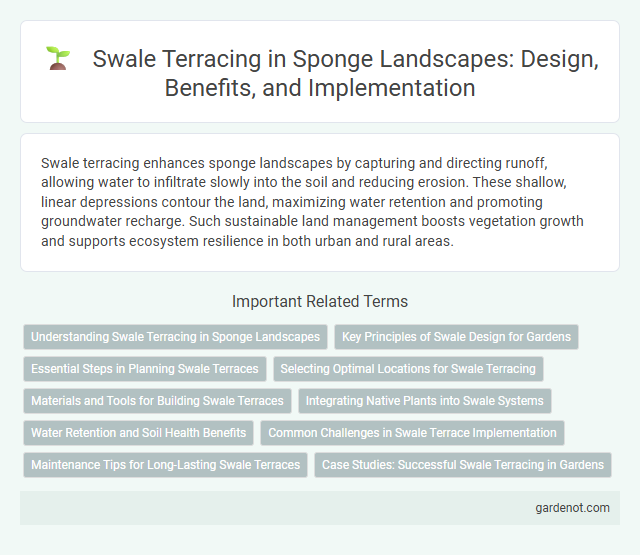Swale terracing enhances sponge landscapes by capturing and directing runoff, allowing water to infiltrate slowly into the soil and reducing erosion. These shallow, linear depressions contour the land, maximizing water retention and promoting groundwater recharge. Such sustainable land management boosts vegetation growth and supports ecosystem resilience in both urban and rural areas.
Understanding Swale Terracing in Sponge Landscapes
Swale terracing is an effective water management technique used in sponge landscapes to capture and infiltrate rainwater, reducing runoff and soil erosion. By creating shallow, contour-aligned depressions on sloped terrain, swales slow water flow and increase groundwater recharge. This sustainable practice enhances soil moisture retention and supports vegetation growth, contributing to resilient and productive ecosystems.
Key Principles of Swale Design for Gardens
Swale terracing in gardens optimizes water management by capturing and directing runoff to enhance soil moisture retention and reduce erosion. Key principles of swale design include contour alignment to follow natural land gradients, adequate size and slope for effective water infiltration, and integration with native vegetation to stabilize soil and increase biodiversity. Properly designed swales improve groundwater recharge while supporting sustainable, resilient landscape ecosystems.
Essential Steps in Planning Swale Terraces
Planning swale terraces involves assessing topography and soil permeability to ensure optimal water absorption and runoff management. Delineating contour lines accurately guides the placement of swales, promoting effective erosion control and groundwater recharge. Incorporating native vegetation stabilizes the terraces, enhances filtration, and supports sustainable landscape integration.
Selecting Optimal Locations for Swale Terracing
Selecting optimal locations for swale terracing involves identifying areas with gentle to moderate slopes that facilitate effective water capture and infiltration. Priority should be given to sites with high runoff potential and compacted soils, as swales help reduce erosion and enhance groundwater recharge. Proper placement along contour lines maximizes water retention and supports sustainable sponge landscape design.
Materials and Tools for Building Swale Terraces
Swale terracing primarily uses natural materials such as soil, mulch, and native vegetation to enhance water retention and prevent erosion. Essential tools for constructing swale terraces include shovels, spades, and laser levels, ensuring precise contouring and effective water flow management. Incorporation of organic compost and gravel further stabilizes the terraces, promoting soil fertility and long-term sustainability.
Integrating Native Plants into Swale Systems
Integrating native plants into swale terracing enhances water absorption and stabilizes soil, promoting ecosystem resilience. Native species such as switchgrass, black-eyed Susan, and sedges are well-adapted to local climate and soil conditions, optimizing nutrient retention and reducing erosion. Their deep root systems improve groundwater recharge and support biodiversity within sponge landscape designs.
Water Retention and Soil Health Benefits
Swale terracing in sponge landscapes enhances water retention by capturing and slowly infiltrating rainwater, reducing surface runoff and groundwater depletion. This technique increases soil moisture levels, promoting healthier root systems and improving nutrient availability. Improved soil structure through organic matter buildup reduces erosion and supports diverse microbial activity essential for long-term soil fertility.
Common Challenges in Swale Terrace Implementation
Swale terrace implementation often faces common challenges such as soil erosion, poor water infiltration, and inadequate slope stabilization. Failure to properly design and maintain swales can lead to waterlogging or reduced effectiveness in controlling runoff. Addressing these issues requires precise grading, suitable vegetation selection, and regular monitoring to ensure optimal sediment retention and moisture management.
Maintenance Tips for Long-Lasting Swale Terraces
Regular inspection of swale terraces ensures optimal water flow and prevents erosion by identifying blockages or damage early. Vegetation management, including planting deep-rooted native grasses and periodic trimming, stabilizes soil and enhances water infiltration. Maintaining swale shape and slope through periodic reshaping and avoiding heavy machinery reduces soil compaction and preserves terrace integrity.
Case Studies: Successful Swale Terracing in Gardens
Swale terracing effectively manages water runoff and enhances soil moisture retention in garden landscapes, as demonstrated by case studies from urban and suburban settings. Notable examples include residential gardens in Australia and California, where swale terraces reduced erosion and improved plant health by directing rainwater to tree roots and garden beds. These successes highlight the importance of strategic swale placement and native plant integration for sustainable garden water management.
Swale terracing Infographic

 gardenot.com
gardenot.com